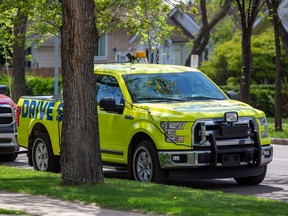There was never any strong argument for Edmonton to hammer on drivers more than any other Canadian city.

Article content
If Edmonton politicians don’t like the province’s move to axe all speed trap “fishing holes,” they only have themselves to blame.
Article content
Article content
Edmonton had three of Alberta’s top five revenue-generating sites last year, Gateway Boulevard at 34 Avenue, 170 Street at 118 Avenue, and 127 Street at 126 Avenue.
Between them they pulled in $7.1 million in fines.
Those “fishing holes,” as Transportation Minister Devin Dreeshen calls them, will be gone as of next April 1, along with 70 per cent of Alberta’s 2,200 current photo radar sites.
Advertisement 2
Article content
It’s about time. The moment city politcians and bureaucrats got control of photo radar more than a decade ago, they secretly lowered the tolerance for speeding, they jacked up the number of photo radar locations, and they put in photo radar in all kinds of places where there was a low incidence of collisions.
There was never any strong argument for Edmonton to hammer on drivers more than any other Canadian city. Our collision numbers are driven by ice, snow and a constellation of bad driving habits, only one of which is speeding.
Of course, it might well be reasonable to ignore my verdict as the rantings of a photo radar hater but during this debate numerous civic politicians, police officers and radar enforcement personnel have spoken out against the cash grab.
There were rarely any complaints about photo radar for the 20 years the police ran the program in the 1990s and 2000s. You generally had to be going more than 15 km/h over the limit to get a ticket, with the whole aim of the program to target the small percentage of drivers who go faster than the safe flow of traffic.
When city photo radar operators took over, revenue more than doubled, in large part because the tolerance for speeding was secretly dropped to 10 km/h and lower.
Article content
Advertisement 3
Article content
Jim Howse, a former city police officer who ran traffic safety programs, said he was alarmed to hear city traffic authorities now saying you can get a ticket for going as little as one km/h over the limit. “Can you envisage a situation where every driver afraid of being charged drove under the posted speed limit? Massive road rage.”
Citizens complained that photo radar was put in places with low risk of collisions. In 2015, former photo radar operator Alan White admitted it, saying the city’s hunger for new revenue was just as strong as its intention to keep our roads safe.
If operators did not get high numbers of violations, they were directed to go to sites where more speeders would be caught, White said. “That’s not about safety anymore. That’s about, ‘Let’s get the numbers up.’”
In 2016 then-Morinville mayor Lisa Holmes spoke out about the need to not let photo radar operators have free rein. If a photo radar contractor is getting paid per ticket, Holmes said, they will sit at a certain site if they know it has a huge amount of traffic, even if there’s no real safety issues there. “They were spending 90 per cent of their time in three different spots that were on the edge of a town and it’s just like it was a bit of a cash cow, honey pot situation.”
Advertisement 4
Article content
That same year, retired RCMP officer Mike Steneker, who patrolled Queen Elizabeth II Highway near Leduc, said, “Photo radar does not make the roads safer. Speed is just easy to enforce compared to the real culprits.”
When Steneker and his partner dug into collision reports over a 10-year period in the Leduc area, they found not one traffic injury could be blamed on speed. Instead, injuries and deaths were caused by distracted driving, impaired driving, drivers merging too slowly, improper maintenance of cars and trucks, folks not wearing seat belts, and drivers parked at the side of the road.
Rachel Notley’s government studied photo radar and found that Alberta’s unprecedented embrace of photo radar had led to just a small reduction in accidents, 1.4 per cent over an eight-year period, compared to jurisdictions that didn’t have photo radar.
Jason Kenney’s UCP brought in some limitations to photo radar, with Premier Danielle Smith now essentially closing the deal on fishing holes.
Red light cameras will remain, but there will be no photo radar outside of construction, school and playground zones. If Edmonton thinks it has a major trouble spot for speed collisions, it can request additional two-year photo radar locations “on an exceptional basis.”
Advertisement 5
Article content
Photo radar should never have been about revenue generation, Dreeshen said. “It’s a tool that should be making our roads safer. And if it’s not, if it’s about making municipalities money, well, that’s a cash cow, and that’s ending.”
Amen.
Recommended from Editorial
Bookmark our website and support our journalism: Don’t miss the news you need to know — add EdmontonJournal.com and EdmontonSun.com to your bookmarks and sign up for our newsletters.
You can also support our journalism by becoming a digital subscriber. Subscribers gain unlimited access to The Edmonton Journal, Edmonton Sun, National Post and 13 other Canadian news sites. The Edmonton Journal | The Edmonton Sun
Article content

